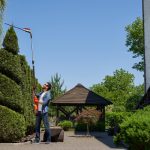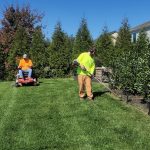By the time November hits in Elgin, our focus shifts quickly to winter. Mornings get colder, daylight disappears faster, and snow could show up any week. For commercial properties, this time of year is more than just about staying warm. It is the last chance to take care of outdoor maintenance before everything freezes. Delaying these jobs can lead to damaged equipment, safety issues, and expensive repairs by spring.
Commercial landscape maintenance in late fall is more than something to check off a list. It is a way to protect property, keep people safe, and avoid dealing with surprises once the snow melts. With the first frost already behind us and December on the horizon, mid-November is the perfect time to finish the jobs that matter most outside.
Inspect and Winterize Irrigation Systems
If it has not already been done, irrigation systems need attention right away. Even if they were used less in the fall, any leftover water sitting in the lines can freeze when temperatures drop hard overnight. That frozen water expands inside the pipes and often leads to cracks, leaks, or breaks that go unnoticed until spring.
Shutting off the water supply to the system is the first step. Flushing or blowing out each zone is next, clearing out any remaining water. This includes underground lines, backflow devices, and drip systems around plant beds. Skipping this step can lead to big repairs when it warms up.
This is also a good time to inspect every zone for signs of trouble. Broken sprinkler heads, loose fittings, or misaligned zones should be fixed now. Irrigation repairs are much harder once the ground freezes, and small issues only grow over time if ignored. Bright Green Landscapes offers winter irrigation system shutdowns and full inspections for commercial properties.
Clear Leaves and Organic Debris from High-Traffic Areas
Leaves look pretty as they fall, but they build up fast and can create problems if left sitting. Wet leaves break down quickly and get very slippery around walkways, building entrances, and parking lots. That creates a real risk for slip-and-fall injuries when frost sets in or snow covers the ground.
Piled leaves can also clog storm drains, trap water, and keep moisture pooled close to foundations. This sitting water is trouble in winter, especially when it freezes and spreads into cracks or weak spots.
The best approach is to focus on high-traffic and visible areas, such as stairways, fire lanes, outdoor seating, and loading dock entries. Removing debris from these locations makes a difference in both safety and appearance. Clean out plant beds near buildings too, since wet debris brings pests and mold.
Cut Back Perennials and Prepare Beds for Dormancy
Most garden plants are at season’s end by mid-November. Many perennials benefit from being pruned or thinned. Some can be left with extra height, since stems help shield crowns from cold. Dead annuals, and any remaining blackened stems or leaves, should be removed.
Tidying up beds does more than make things look clean. It lowers the risk of disease and rot, especially in sheltered corners. Compact leaves or puddled stems create moist zones right near the soil. Rot and fungus can move in quietly and kill plants by spring.
After beds are cleaned, applying a light layer of mulch helps. It does not have to be thick—just enough to keep soil temperatures steady and hold borders in place. Last-minute mulching keeps beds from shifting or eroding, while making spring cleanups easier.
Inspect Trees and Shrubs for Structural Weakness
Trees and shrubs should not be overlooked before winter. A cracked limb or a damaged trunk could give out under snow or ice, which becomes much riskier if it is near a walkway or building.
Check any branches extending into busy walkways or over parking. Large limbs near windows or rooflines need to be checked even more closely. A small broken limb can become a larger hazard fast under windy or snowy weather.
Trimming overgrown trees, clearing twigs near HVAC units, or reshaping shrubs before winter reduces that risk. Clearing the way now means fewer hassles with storm cleanup or frozen branches later.
Evaluate Hardscape Features and Drainage Systems
Stone walkways, patio edges, and decorative walls are all at risk after freeze-and-thaw cycles. If these features start with cracks or loose materials, everything will only get worse as winter goes on. Inspect these hard surfaces early, especially those by parking and building entrances.
Storm grates and drains should be checked to make sure they are fully clear. If runoff gets blocked, water will collect and freeze. Frozen puddles or icy patches are common problems for commercial properties in winter.
Look for low pavers, uneven joints, cracked edges, or shifting stones. Even small gaps can become hazards or grow into major repairs. Light fixes now can prevent a lot of cost and trouble when spring thaws everything out again. Bright Green Landscapes can assess hardscape issues and drainage around commercial lots, helping address these trouble spots before winter.
Start Winter Ready, Finish Spring Strong
Winter prep for commercial properties is about more than being ready for snow. It is about staying ahead of emergency repairs, avoiding accidents, and keeping everything looking clean and professional no matter the weather. This is why autumn maintenance is worth every hour invested now.
When commercial grounds are closed out clean, drains are clear, irrigation is safe, and beds and trees are stable, the property sails through the hardest months in better shape. That means fewer problems in spring and more time to focus on fresh upgrades instead of urgent repairs. Solid fall maintenance turns a potential scramble into a smoother, safer start for the next season.
Managing commercial properties in Elgin takes planning, especially as the weather shifts. From trimming back dead limbs to shutting down irrigation, small steps now can prevent bigger headaches once the deep freeze hits. Winter prep helps keep walkways safer and grounds easier to manage. Our commercial landscape maintenance programs are built to handle exactly that. Contact Bright Green Landscapes to get on the schedule before the season changes for good.







